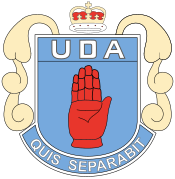
Back جمعية الدفاع اولستر ARZ Asociación en Defensa del Ulster AST Асацыяцыя абароны Ольстэра Byelorussian Associació de Defensa de l'Ulster Catalan Ulsterské obranné sdružení Czech Ulster Defence Association German Asociación en Defensa del Úlster Spanish Ulsterren Defentsarako Elkartea Basque Ulster Defence Association Finnish Ulster Defence Association French
| Ulster Defence Association | |
|---|---|
 Emblem of the Ulster Defence Association | |
| Leaders |
|
| Dates of operation | September 1971 – present (on ceasefire since October 1994; ended armed campaign in November 2007) |
| Group(s) |
|
| Headquarters | Belfast[2] |
| Active regions |
|
| Ideology | |
| Size | |
| Allies |
|
| Opponents | |
| Battles and wars | The Troubles |
| Designated as a terrorist group by | |
| Flag |  |
The Ulster Defence Association (UDA) is an Ulster loyalist paramilitary[9] group in Northern Ireland. It was formed in September 1971 as an umbrella group for various loyalist groups[10] and undertook an armed campaign of almost 24 years as one of the participants of the Troubles. Its declared goal was to defend Ulster Protestant loyalist areas[10] and to combat Irish republicanism, particularly the Provisional Irish Republican Army (IRA). In the 1970s, uniformed UDA members openly patrolled these areas armed with batons and held large marches and rallies. Within the UDA was a group tasked with launching paramilitary attacks that used the cover name Ulster Freedom Fighters (UFF) so that the UDA would not be outlawed. The British government proscribed the UFF as a terrorist group in November 1973, but the UDA itself was not proscribed until August 1992.[11][12]
The UDA/UFF were responsible for more than 400 deaths. The vast majority of its victims were Irish Catholic civilians,[13][14][15] killed at random, in what the group called retaliation for IRA actions or attacks on Protestants.[16][17][18][19][20] High-profile attacks carried out by the group include the Top of the Hill bar shooting, the Milltown massacre, the Sean Graham's and James Murray's bookmakers' shootings, the Castlerock killings, killings of Paddy Wilson and Irene Andrews and the Greysteel massacre. Most of its attacks were in Northern Ireland, but from 1972 onward it also carried out bombings in the Republic of Ireland. The UDA/UFF declared a ceasefire in 1994 and ended its campaign in 2007, but some of its members have continued to engage in violence.[21] The other main Loyalist paramilitary group during the conflict was the Ulster Volunteer Force (UVF). All three groups are proscribed organisations in the United Kingdom under the Terrorism Act 2000.[11]
- ^ a b David Lister and Hugh Jordan, Mad Dog: The Rise and Fall of Johnny Adair
- ^ "How the RUC protected the UDA". Irish Times. Archived from the original on 11 November 2020. Retrieved 9 October 2019.
On May 26th, 1981, the RUC searched UDA headquarters in Belfast ...
- ^ N. J. Haagerup (1983–1984). "Report drawn up on behalf of the Political Affairs Committee on the situation in Northern Ireland" (PDF). European Parliament. European Communities. Archived (PDF) from the original on 8 October 2018. Retrieved 9 October 2018.
- ^ "There is a high correlation between racist attacks and areas which are staunchly Loyalist and a traditional heartland for affiliation to prominent Loyalist paramilitary groups such as the Ulster Volunteer Force (UVF) and Ulster Defence Association (UDA)".
- ^ Organisations: U Archived 22 February 2011 at the Wayback Machine, CAIN
- ^ "Loyalist paramilitary groups in NI 'have 12,500 members'". BBC News. 2 December 2020. Archived from the original on 2 December 2020. Retrieved 3 August 2021.
- ^ David Lister and Hugh Jordan Mad Dog: The Rise and Fall of Johnny Adair
- ^ "UFF condemns death threats". BBC News. 15 January 2002. Archived from the original on 23 September 2021. Retrieved 28 March 2010.
- ^ Mulholland, Marc. Northern Ireland: A very short introduction. Oxford University Press, 2002. p.80
- ^ a b "A history of the UDA". BBC News. 6 January 2010. Archived from the original on 26 July 2017. Retrieved 28 March 2010.
- ^ a b "Proscribed terrorist groups or organisations". Home Office. Retrieved 24 December 2021.
- ^ 'A History of the UDA' BBC News. Retrieved 28 December 2021
- ^ "Sutton Index of Deaths: Crosstabulations". Conflict Archive on the Internet (CAIN). Archived from the original on 24 March 2016. Retrieved 15 March 2011. – choose "organisation" as First Variable and "status summary" as Second Variable
- ^ Wright-Neville, David (2010). Dictionary of Terrorism. Polity. p. 194.
Between the late 1960s and 2007, the UDA carried out more than 250 killings, the victims of which were mainly Catholic civilians.
- ^ "Sutton Index of Deaths: Crosstabulations". Conflict Archive on the Internet (CAIN). Archived from the original on 24 March 2016. Retrieved 15 March 2011. – choose "organisation" as First Variable and "religion summary" as Second Variable
- ^ Nelson, Sarah (1984). Ulster's Uncertain Defenders: Loyalists and the Northern Ireland Conflict. Belfast: Appletree Press. pp. 117–127.
- ^ McKittrick, David (20 January 1998). "Ireland: 'Many of Belfast's most deadly acronyms are now back in action". The Independent. Archived from the original on 20 October 2017.
- ^ "Stevens Inquiry: Key people". 17 April 2003.
- ^ "UK agents 'worked with NI paramilitary killers'". BBC News. 28 May 2015.
- ^ "Pat Finucane murder: 'Shocking state collusion', says PM". BBC News. 12 December 2012.
- ^ "UFF given the order to stand down". BBC News. 12 November 2007. Archived from the original on 19 August 2017. Retrieved 28 March 2010.
© MMXXIII Rich X Search. We shall prevail. All rights reserved. Rich X Search